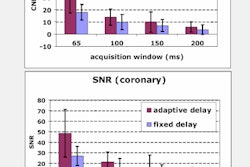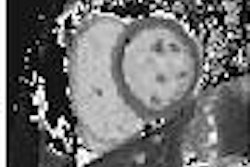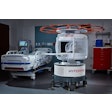Amid all of the turf warfare -- cardiologists versus radiologists, self-referral, and so on -- one of the more bizarre consequences has been a backlash against the idea of decentralizing the services that radiologists and radiologic technologists perform.
Clinically, there are strong arguments for providing sophisticated imaging in emergency departments and surgical suites, but there is a nostalgic attachment to the idea of radiology as a department, a single geographic place within the hospital -- a concept that runs contrary to contemporary pressures and the idea of decentralization.
Certainly some of the best arguments for keeping radiology consolidated have to do with staffing and infrastructure, but the tendency to see diagnostic functions as a destination and not a service ignores their role in the patient care path. What if radiology lost its borders and became an archipelago of modalities and services? What if these service cells came to the patient whenever possible (as in portable x-ray or ultrasound), or if stationary modalities, such as CT or MR, were positioned in the hospital where they best fit with the critical path of patient care? Perhaps this means one CT near the emergency department and one near a cardiac unit or a surgical suite, instead of three clustered at one end of the hospital.
With teleradiology we've already proved that a decentralized process works by distributing interpretation to geographically scattered radiologists, now we need to decentralize the other end, the part with the patient. If we are to make the patient care process more efficient and effective, we need to identify where the patients arrive, what they need, and where they're going. Scenic byways may be great for hiking, but rolling patients back and forth across a hospital to provide them with these services means less efficient buildings and staffing and slower delivery of care.
Women's health units are nothing new, but they found success in bringing ultrasound and mammography, along with a host of other services, directly to the patients who needed them. This model could very easily be replicated elsewhere where, unlike traditional radiology departments, patients are gathered on the basis of their condition and the care they need. Part of the friction between radiologists and cardiologists is that the heart doctors' patients have clinical similarities for which it makes sense to bring these diagnostic tools to the patient. This friction will only escalate as orthopedists and oncologists recognize how similar their position is to that of cardiologists.
So how does a facility make the cognitive leap from radiology department to imaging services? They do it through a careful analysis of patient care paths. While every hospital tracks admissions, how many could tell you the typical sequence of care for patients of the most common admissions? The patients admitted with chest pain to the ER and discharged one to three days later, between the time they arrive at the hospital's doorstep and the time they leave, where do they go? What tests are performed? Which specialty services are provided? What diagnostics are done? What are the treatments applied? If you mapped this path on a floor plan of a hospital, would it be a relatively short, straight line or would it look more like one of Bill Keane's "Family Circus" comic strips with young Billy meandering along a dotted-line path through the building?
While unique cases always provide exceptions, many hospitals could readily identify six to 10 typical patient treatment paths that comprise a significant proportion of its annual volume. If these sequences of care were identified in individual flow charts and the common points identified (for example, both the motor vehicle accident trauma and the chest pain patient are likely to receive CT scans), the new multidisciplined flow chart can be superimposed on the hospital's floor plan.
Though the superimposed flow chart is likely to be significantly different than the layout of a facility, don't lose hope. The disparities between the current state and the optimal layout should become mile markers for a strategic plan. In some cases, it may take only a few years to realize significant portions of this plan, although the domino effect of moving functions or departments may extend the timeline over many years. But each step in the process will help healthcare facilities move closer to optimized patient care and efficiency.
But what about those facilities that believe circumstances prohibit them from taking such a drastic step? The fact is that hospitals, even those that would scoff at the idea of a paradigm shift, have begun to do this already. Is a cath lab/angio suite located near the emergency department? Are you regularly performing procedures guided by C-arms in the operating room? What about joint ventures between hospitals and practice groups for outpatient treatment and diagnostic services? If you've answered "yes" to any of these, then you are already an integral part of this transition.
At the individual level, the technologist with the patient or the radiologist with the image, there is no difference between the radiology department and an imaging service-line. But the healthcare system is intended to serve the patient, and given the labyrinthine paths along which many patients are wheeled to receive their care, we aren't providing that care in a very efficient manner.
Given the financial pressures to maximize throughput and minimize patient stays, doesn't it make sense to bring the modality to the patient, when the volumes are there to support it? And if you can cut just 100 paces off of the distance that patients need to be wheeled, how many miles of patient transport have been eliminated over the course of a year? What impact does that have on full-time equivalent (FTE) employees?
Significant issues still remain with staffing and operations for decentralized imaging services within a hospital, and individual facilities may weigh the options and choose to remain with a consolidated radiology department. But the pressures of efficiency and accelerated patient care will continue to exert themselves and are likely, over time, to dramatically reshape the radiology department as we understand it today.
By Robert Junk and Tobias Gilk
AuntMinnie.com contributing writers
June 23, 2006
Reprinted from www.mri-planning.com by permission of the authors. If you would like more information on any aspect of MR facility design or safety, please contact Robert Junk or Tobias Gilk at Jünk Architects.
Related Reading
Keeping Zone III secure: Access controls for MRI suites, June 7, 2006
Magnet room doors and quench entrapment, May 22, 2006
When MRI throughput means more than revenue, April 11, 2006
ECRI's report on MRI safety, March 28, 2006
Doubling down: Raising the stakes of MRI patient safety, March 9, 2006
Copyright © 2006 Jünk Architects, PC



.fFmgij6Hin.png?auto=compress%2Cformat&fit=crop&h=100&q=70&w=100)




.fFmgij6Hin.png?auto=compress%2Cformat&fit=crop&h=167&q=70&w=250)











